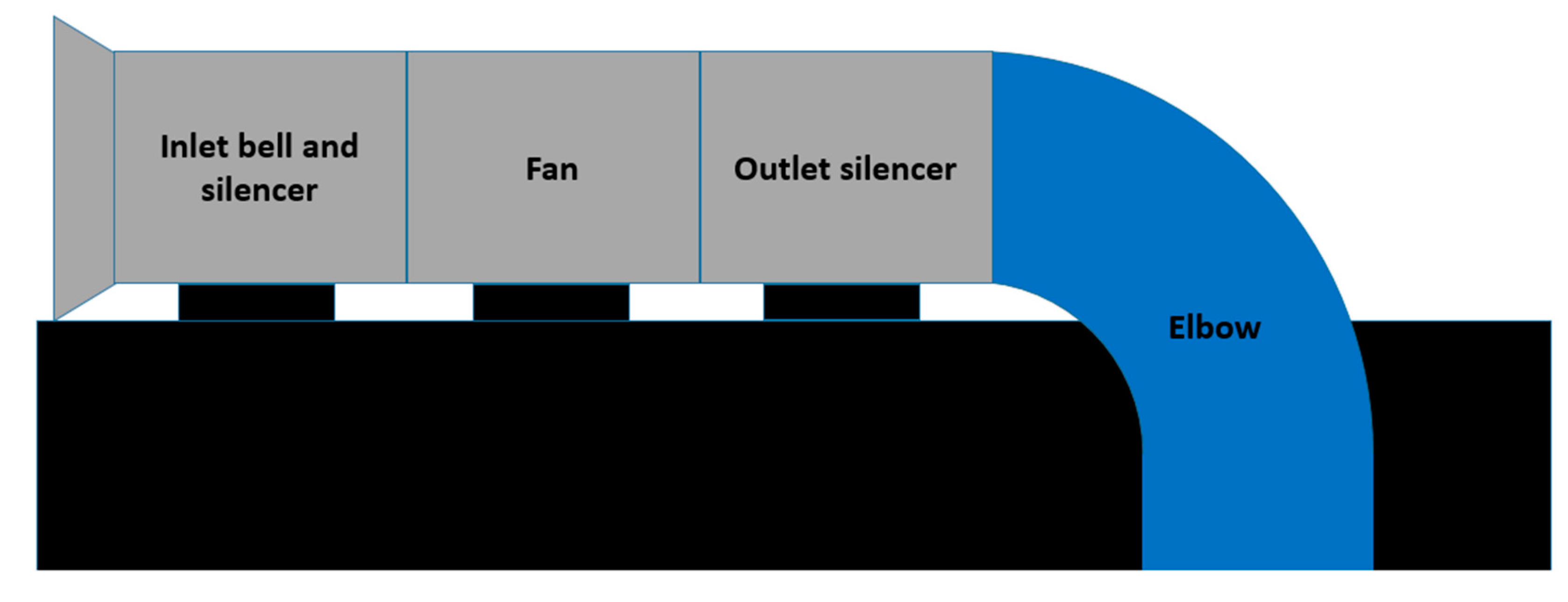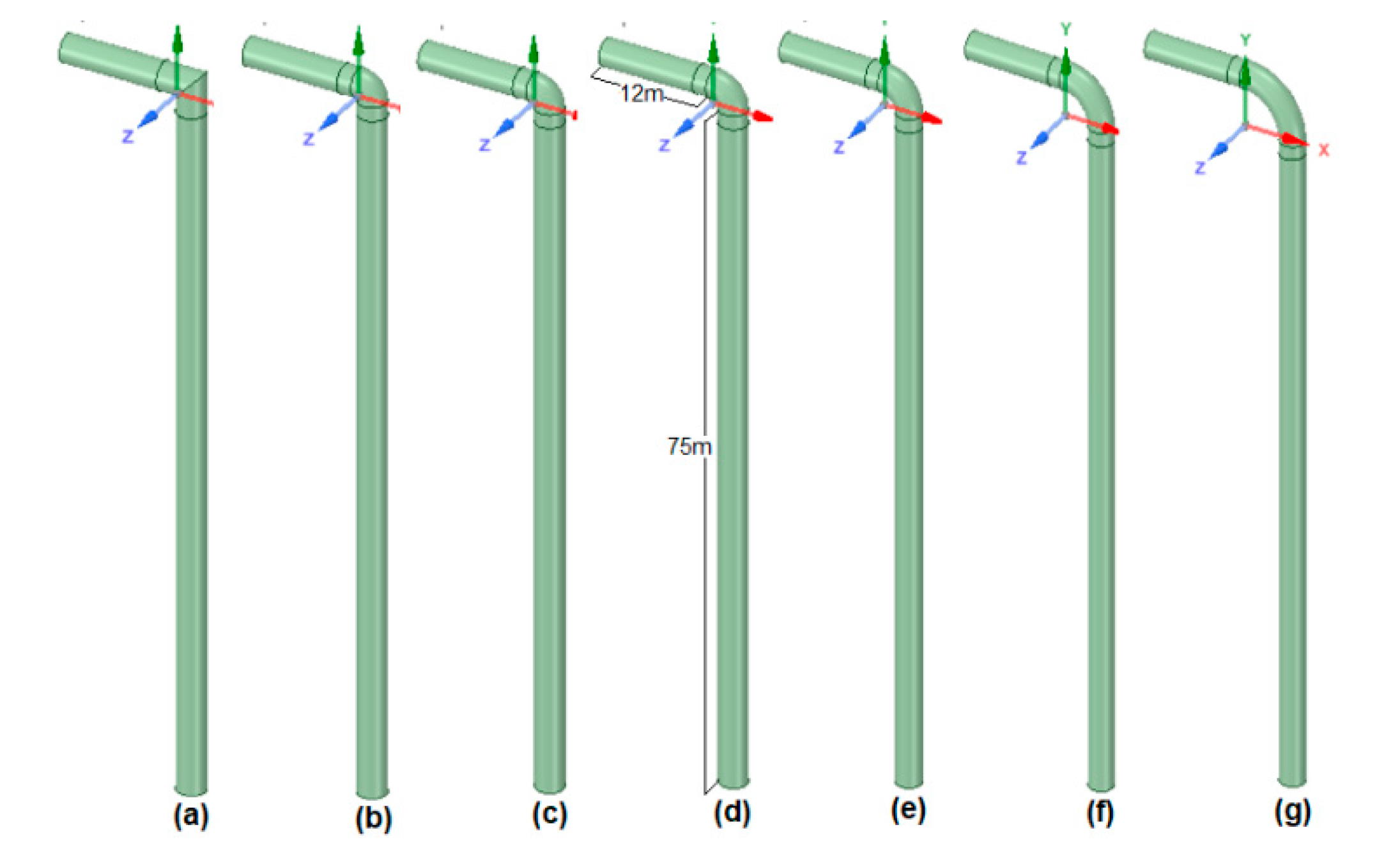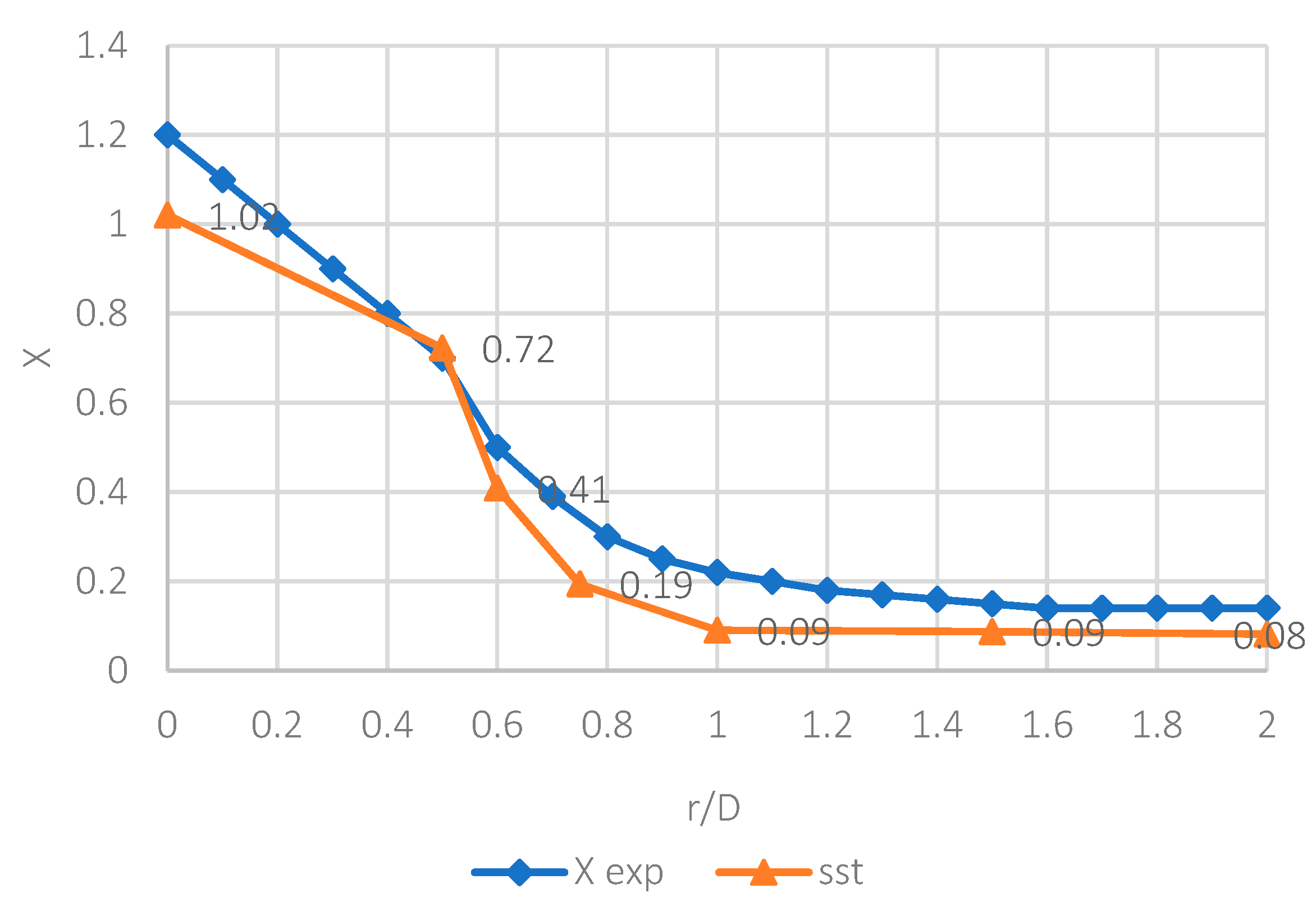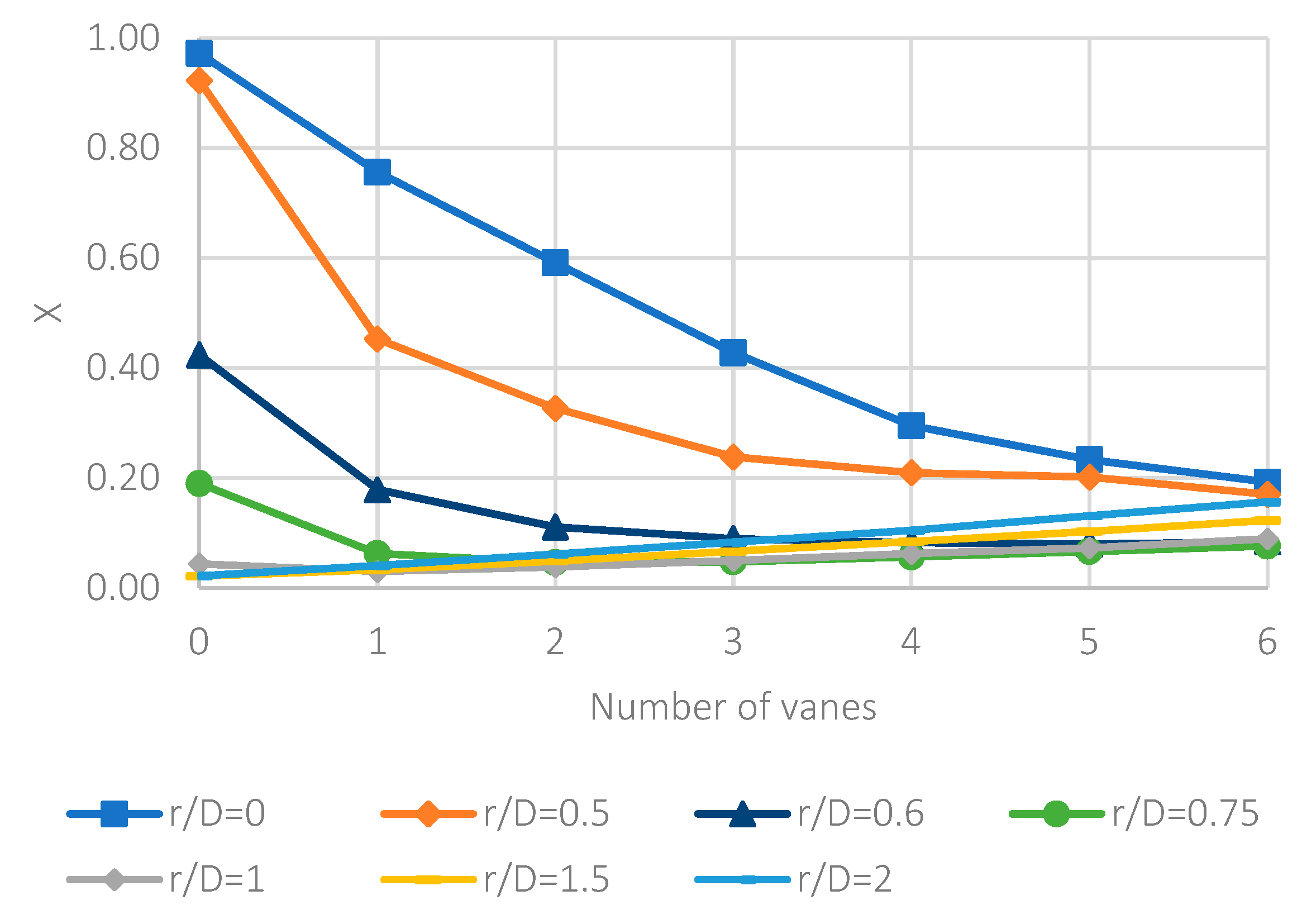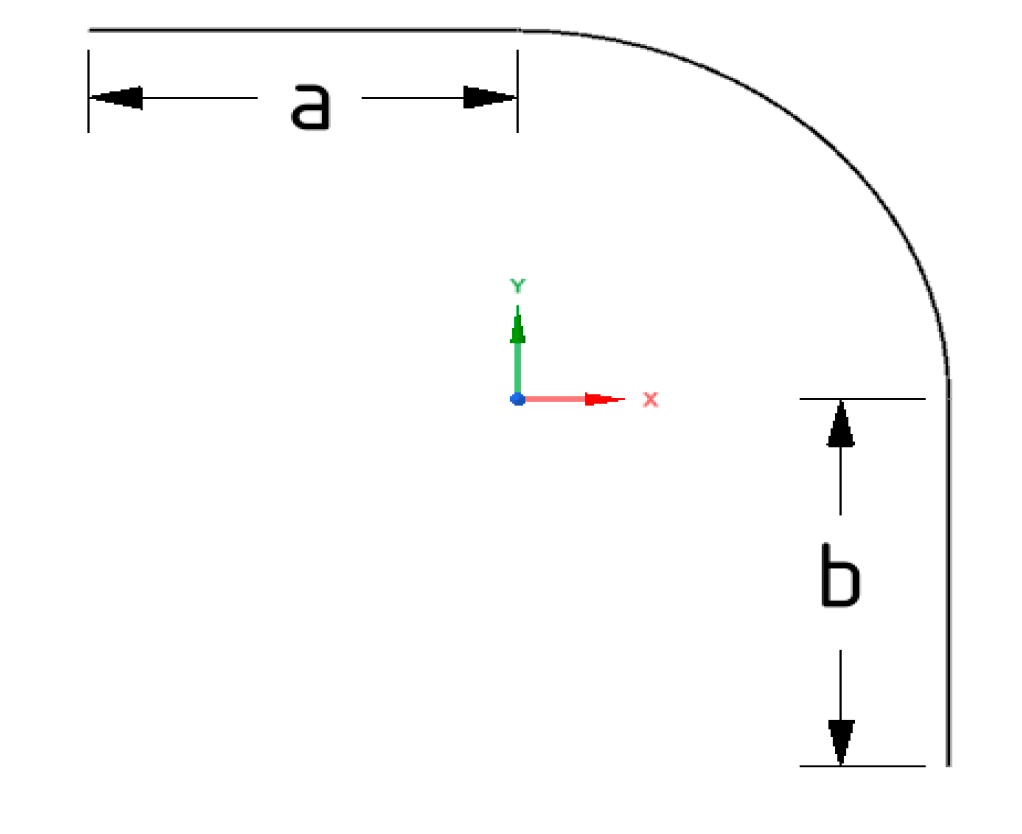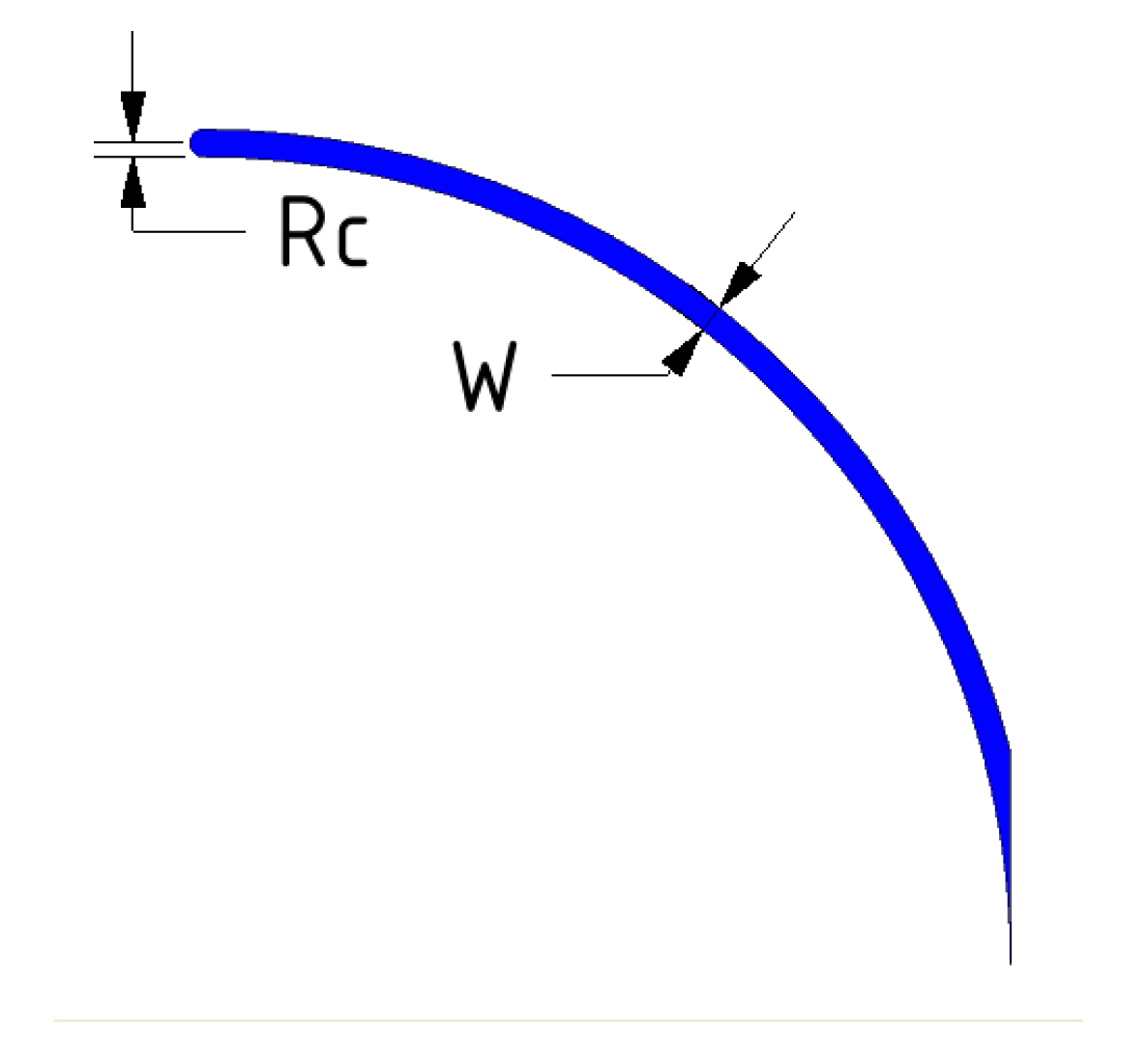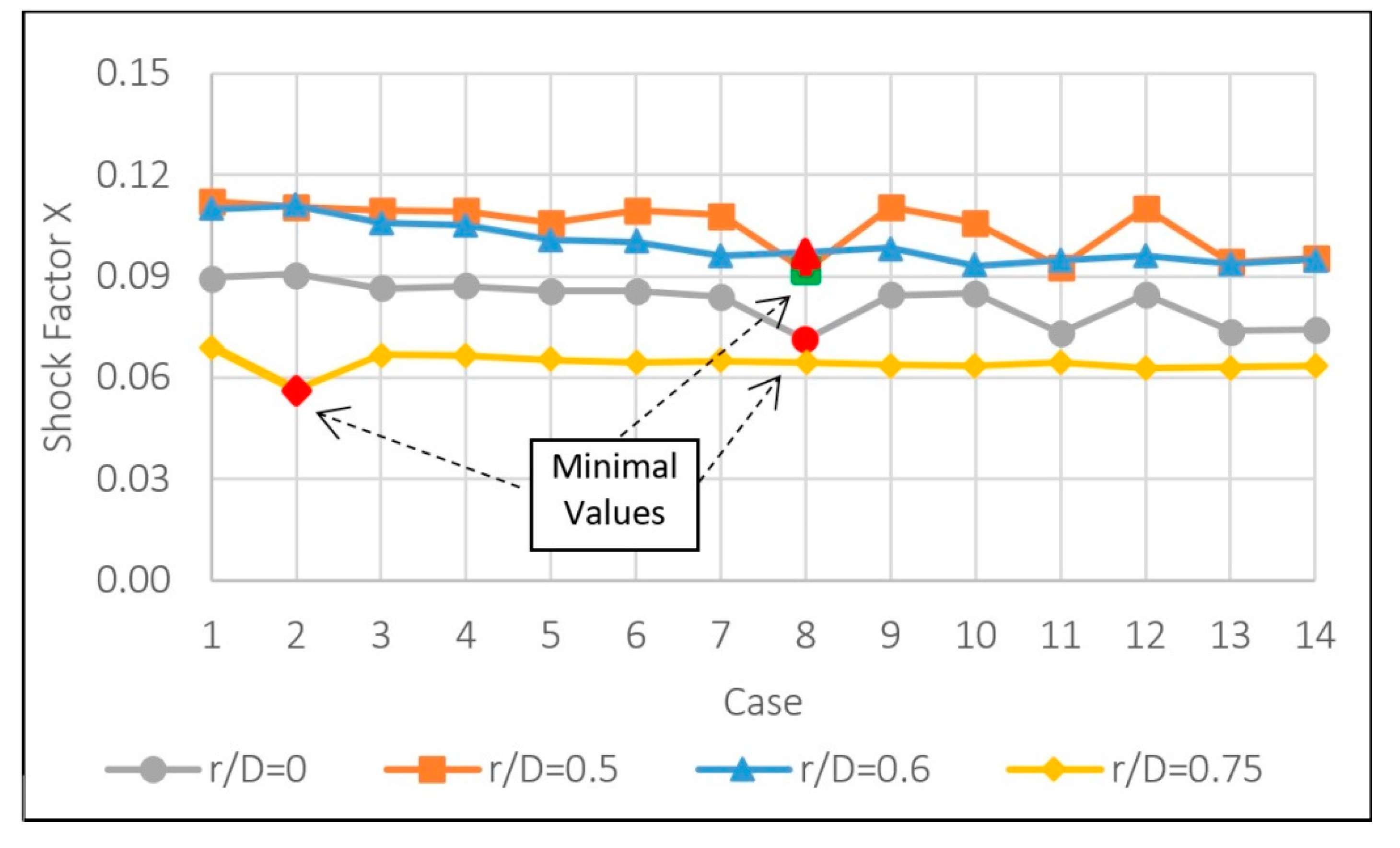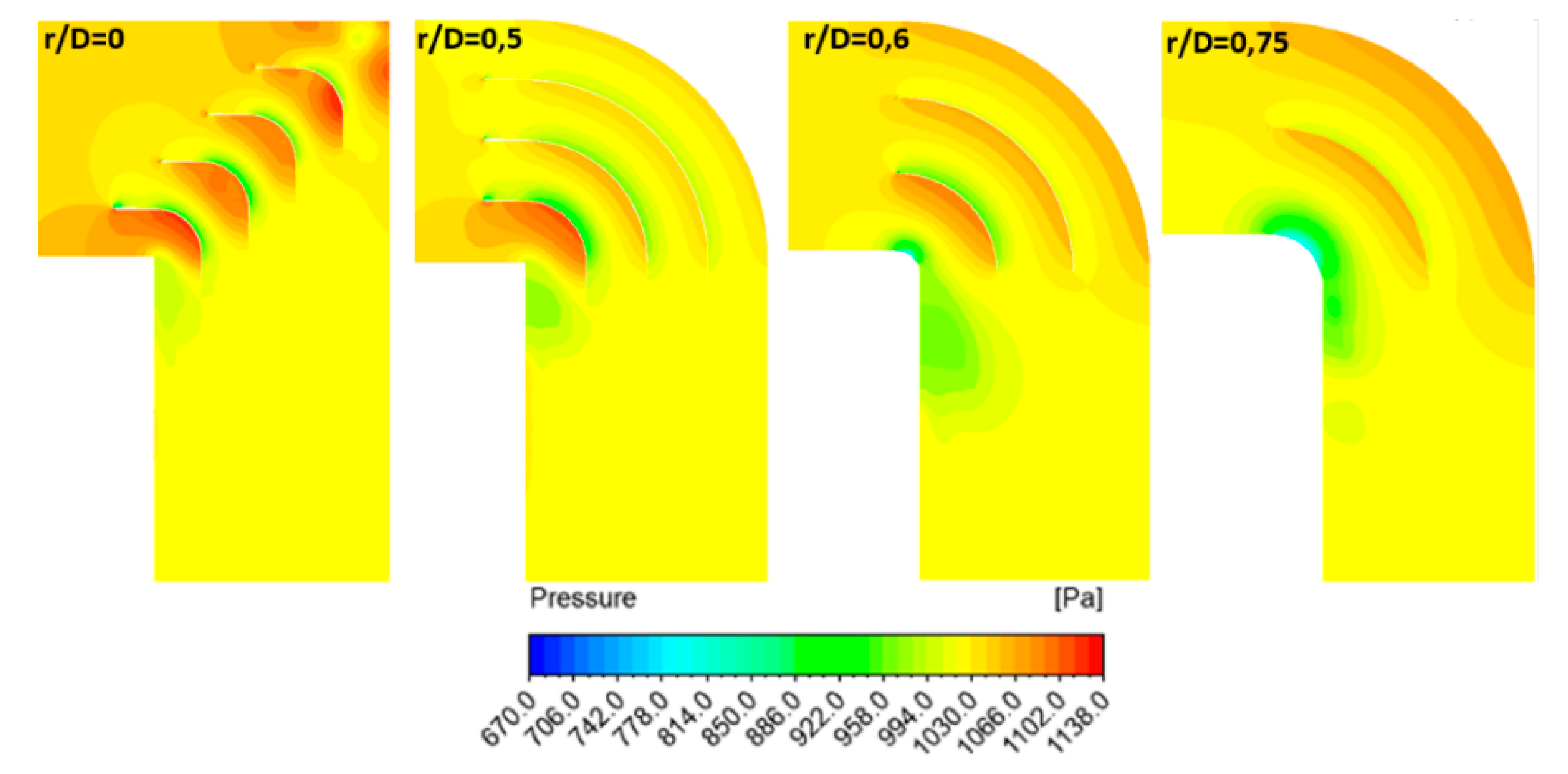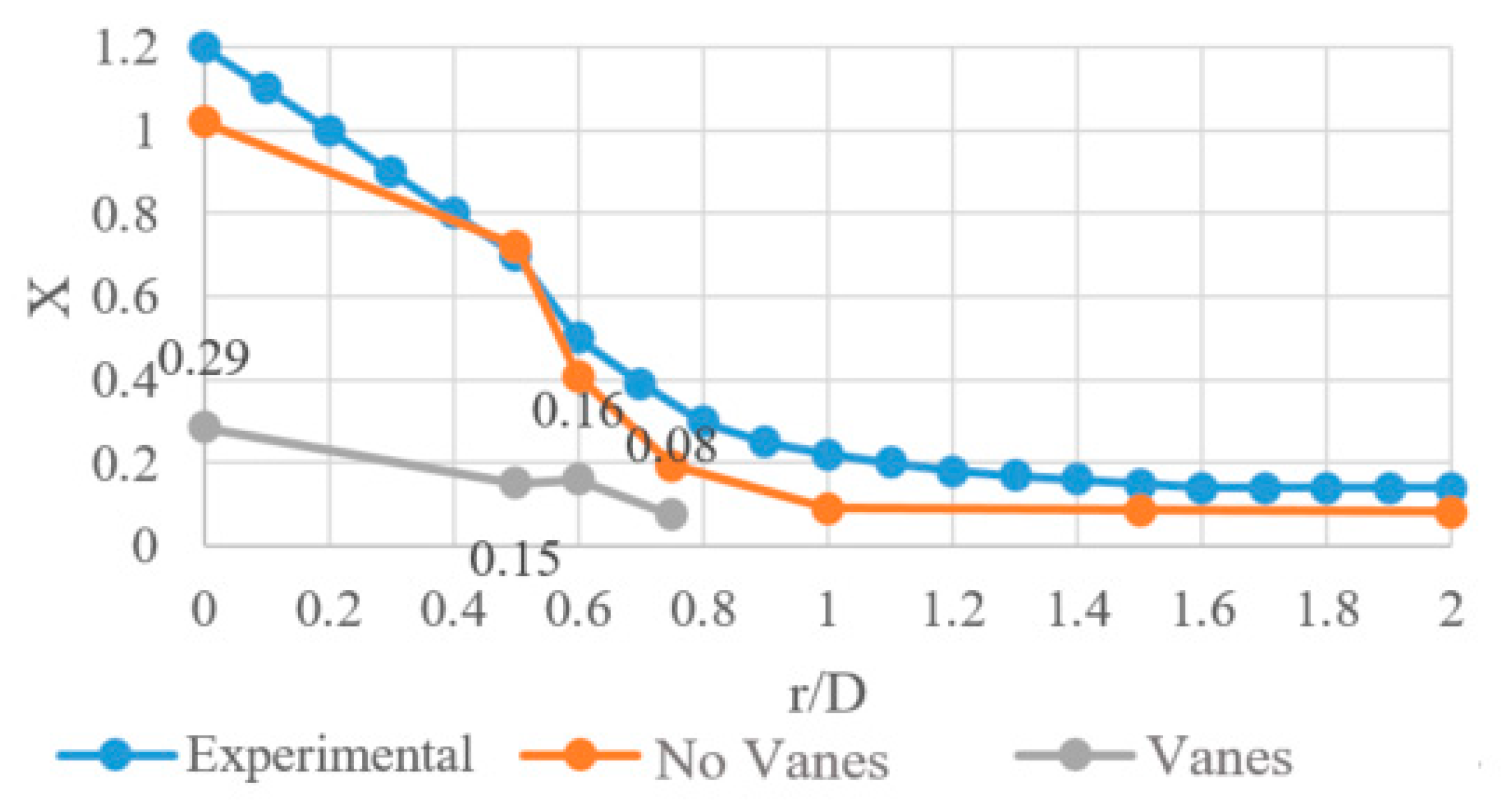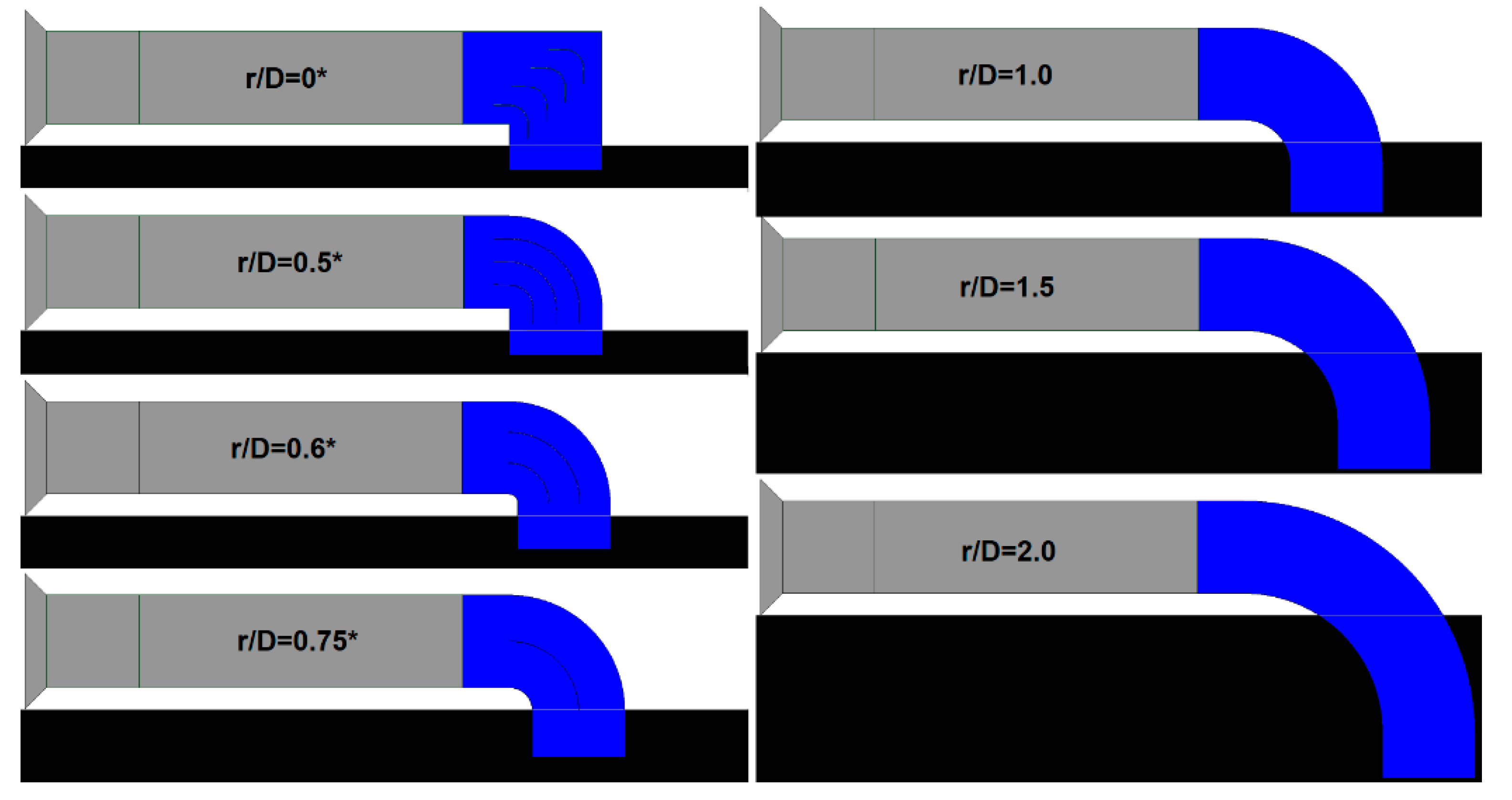1. Introduction
In underground excavations or tunnels for mining or other applications, fans are commonly installed horizontally on the surface. An elbow connection is necessary to supply the airflow volume underground through the intake raise or shaft. In addition, the layout is usually constrained to a short distance between the fan and the shaft, due to the available footprint or the need to minimize capital expenditure, which produces significant shock losses resulting in energy waste. The elbow generates high turbulence due to boundary layer detachment because of a high-pressure gradient. Therefore, the performance of main fans located on the surface is limited by the elbow pressure loss because there are no more openings to help distribute the airflow in parallel and reduce the pressure loss. This pressure loss directly increases the network resistance experienced by the intake fan. In addition, turbulent flows at a 90° elbow can cause strong flow separation near the inner wall, which affects the performance of the duct system and can also cause strong flow-induced vibrations and noise [
1]. This effect is not observed in fans installed vertically in shafts or ventilation raises.
Several authors have studied the effects generated in the flow that passes through an elbow, either for different Reynolds numbers, with different types of fluid, dimensions, pipe roughness, velocity, radius-diameter ratio (r/D), or different angles of curvature, among others. Modi and Jayanti 2004 [
2] indicates that steep angle elbows severely distort downstream flow up to 10 diameters or more and with significant pressure losses. Johnson 2009 [
3] points out that when airflow changes direction in a duct that lacks guide vanes, the duct walls must absorb the sudden impact of the air to redirect the airflow in the desired direction. Several authors have developed specific studies that guide the design, which have been considered for the development of this research work. The state of the art presents various studies and applications, many of them concluding in the reduction of the shock factor or pressure loss coefficient through the incorporation of guide vanes [
2,
3,
4,
5,
6,
7,
8,
9]. Within these studies, and by Enayet et al. 1982 [
10], some incorporate various designs of guide vanes and, therefore, have evaluated the benefits of both the reduction of the shock factor (X) and the distribution of the flow downstream of the elbow, oriented to obtain a less turbulent flow. Johnson 2009 [
3] indicate that guide vanes help airflow make a smoother and more gradual change of direction, resulting in less impact and, therefore, less force transfer. In addition, he emphasizes that an elbow with guide vanes can be 800% more efficient than the same elbow without guide vanes. Kotb and Ward-Smith 1988 [
6] point out that the main method to improve the performance of steep curves is to introduce one or more guide vanes, due to two main reasons: the first is to improve the shape of the velocity profile emerging from the elbow, reducing the peak velocities tending to an average; the second is to reduce the pressure gradient at the elbow between high and low pressures to tend to an average. Regarding the latter, its use is recommended only in elbows with high radio of curvature, as it implies the introduction of additional surfaces that can increase speed gradients and shear forces, and by default increases the friction factor.
On the other hand, Miller 1990 [
8] points out that by using guide vanes the shock factor of acute bends can be reduced to that of circular bends with less losses. Ideally, the guide vanes should be closer to the inner elbow, but due to the thickness of the guide vanes, they could increase resistance considerably, causing a blockage on the inside of the elbow. Guide vanes within elbows are only justified if the radius ratio is less than unity and if the guide vanes are thin, which must be less than 5% of the cross-sectional area. For radius ratios greater than 0.7, a single deflector should be used, which could achieve a 50% loss reduction.
Regarding the aerodynamic design of guide vanes, Sahlin and Johansson 1991 [
11] designed a battery of guide vanes with the aim of minimizing the pressure drop at a 90° elbow, within a wind tunnel (Re 40,000). The designed shape of the guide vane allowed the velocity distribution on the suction side to replicate that of the chosen airfoil, obtaining a crash coefficient with five guide vanes that was as low as 0.036 (Re 154,000), which is approximately one-fifth of what is generally reported with traditional guide vanes. Similarly, Lindgren et al. 1998 [
7] experimentally and numerically studied the design of guide vanes for use in an area-expanding elbow. Experimental results demonstrated that properly designed guide vanes produce very low losses and retain flow quality, even at fairly large expansion rates.
Liou et al. 2001 [
9] studied the effect of the number of guide vanes in a 60° three-dimensional elbow, with a rectangular cross-section that served as a combustion chamber, where he used Laser-Doppler to measure the components of longitudinal, radial, and angular velocity. The main conclusions of Liou et al. 2001 [
9] were that the flow separation gradient decreases with increasing radius of curvature and that the separated flow region along the inner wall decreases with an increasing number of guide vanes. For the case studied, it also concluded that the use of three guide vanes results in a friction loss almost as large as the case without guide vanes, among others.
Modi and Jayanti 2004 [
2] indicated that the use of guide vanes considerably alleviates the flow distortion since the velocity profile is uniformly improved, but it induces friction losses that, in gradual elbows, the reduction of the shock loss can generate even more friction loss. Furthermore, the use of multiple guide vanes follows the law of diminishing returns with an increasing number of guide vanes and with an increasing angle of curvature. Finally, he noticed that the loss coefficient is practically independent of the scale, but the roughness of the wall is not.
In general, existing turbulent models accurately predict friction effects in numerical simulations, but these models are not accurate enough to accurately predict turbulent phenomena due to separation [
12]. In this regard, Crawford and Cunningham 2003 [
12], using CFD modeling, carried out a series of simulations in pipe elbows with r/D of 0.65, 2.5, and 10, respectively, in order to determine the precision of the numerical models and they were compared with experimental results. In particular, four turbulence models were analyzed: the standard k-ε model, the achievable k-ε model, the k-ω model, and a Reynolds Stress model (RSM). The RSM was found to have the best fit, producing accurate pressure loss data for curves with r/D values of 2.5 and 10, however, for the tighter curve with r/D of 0.65, the predictions were significantly worse due to the presence of flow separation, stronger pressure gradients, and high flow line curvatures of 24% to 33%. Kumar and Nandi 2017 [
13] studied, using the k-ε turbulence model, the flow separation and velocity distribution for incompressible turbulent flow through a 90° elbow of r/D = 1 due to the effect of the installed guide vane and determined that the velocity distribution profile was normalized, with very good results.
From the revised literature, it is determined that these works study separately the pressure losses (and turbulence generated) in relation to the radius of curvature and other design variables such as the number of guide vanes, the thickness of the guide vanes, and aerodynamics. From the previous studies, specific patterns are obtained, which establish the main parameters to be considered in the design of the connection elbow between the fan and the ventilation raise, to which the penetration of the guide vanes upstream and downstream of the elbow center must be added. Using the advantages of CFD modeling, the present work develops a combination of these variables to find the optimized design for the connection elbow for a mine ventilation application and different radius of curvature/diameter (r/D) ratios.
In other application areas, such as water supply networks, Vlase et al. 2019 [
14] highlighted the use of finite element analysis to study the behavior of high-density polyethylene pipes by comparing the stress fields. This is an important consideration in terms of utilization and availability of the ventilation network, as the elbow in the mining case is expected to be in service for the life of the mine in most cases. As a result, any elbow failure could result in reduced development and production rates and associated financial losses.
7. Conclusions
A study of guide vanes for the intake fan-duct connection has been presented. The literature review shows the main variables studied that influence the elbow losses at 90°, among which are the radius of curvature (r/D), the incorporation of guide vanes, the number of vanes, the reduction of turbulence, its influence on friction losses, and aerodynamics. Using the advantages of CFD modeling, the study collects all these variables, combines and integrates them into a single study that allows selecting the optimized characteristics according to the radius of curvature of choice. Close to 220 different cases were solved to involve all different variables.
From the obtained results, it can be concluded that is only necessary to use guide vanes for an r/D less than 1.0. For the elbow r/D ratios 1.0, 1.5, and 2.0, it is not beneficial to incorporate guide vanes, since it becomes counterproductive and only generates additional shock losses. For the r/D ratio less than 1.0, the performing fan-shaft connection with r/D rates of 0, 0.5, 0.6, and 0.75 were analyzed and the best number of guide vanes inside are 4, 3, 2, and 1, respectively. If more guide vanes are incorporated, it only generates additional shock losses. The upstream and downstream penetration for guide vanes from the elbow is only applicable to r/D rates of 0 and 0.5 because additional friction losses from guide vanes extensions add more losses from turbulence. The aerodynamic design represented by Rc and W parameters were determined for each r/W case 0, 0.5, 0.6, and 0.75.
Including the optimal guide vanes defined geometries with r/D rates of 0, 0.5, 0.6, and 0.75 allows for selecting the best performing solution in each case. The 3D models show that guide vanes can reduce the area of turbulence and air vorticity in the internal wall downstream of the elbow by approximately 50% or more. The velocity distribution is homogenized after three diameters downstream of the elbows.
The parameters presented here can be scaled for other sizes, taking into account the original 3.0 m diameter and their parameters for the final diameter. It should be considered that the values obtained are only an approximation to the final solution. Future works should consider experimental scale models and CFD simulations to improve the obtained values by adjusting the turbulence models to reach more accurate results.
